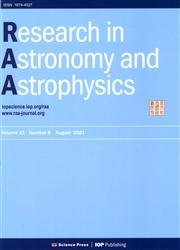Confirmation of a Sub-Saturn-size transiting exoplanet orbiting a G dwarf: TOI-1194 b and a very low mass companion star:TOI-1251 B from TESS
IF 2.8
4区 物理与天体物理
Q3 ASTRONOMY & ASTROPHYSICS
引用次数: 0
Abstract
Abstract We report the confirmation of a sub-Saturn-size exoplanet, TOI-1194 b with a mass about 0.456 -0.051 +0.055 M J , and a very low mass companion star with a mass of about 96.47±1.5 M J , TOI-1251 B. Exoplanet candidates provided by the Transiting Exoplanet Survey Satellite (TESS) are suitable for further follow-up observations by ground-based telescopes with small and medium apertures. The analysis is performed based on data from several telescopes worldwide, including telescopes in the Sino-German multi-band photometric campaign, which aimed at confirming TESS Objects of Interest (TOIs) using ground-based small-aperture and medium-aperture telescopes, especially for long-period targets. TOI-1194 b is confirmed based on the consistent periodic transits depths from the multiband photometric data. We measure an orbital period of 2.310644±0.000001d, and radius is 0.767 -0.041 +0.045 R J , and amplitude of RV curve is 69.36 -7.31 +7.90 m/s. TOI-1251 B is confirmed based on the multi-band photometric and high-resolution spectroscopic data, whose orbiting period is 5.963054 -0.000001 +0.000002 d, the radius is 0.947 -0.033 +0.035 R J , and amplitude of RV curve is 9848.87 -40.08 +41.86 m/s.确认一颗亚土星大小的凌日系外行星绕着一颗G矮星TOI-1194 b和一颗非常低质量的伴星TOI-1251 b运行
摘要:本文报道了凌日系外行星巡天卫星(TESS)提供的一颗质量约为0.456 -0.051 +0.055 M J的亚土星大小的系外行星TOI-1194 b和质量约为96.47±1.5 M J的极低质量伴星TOI-1251 b的确认,这些系外行星候选行星适合用中小型口径地面望远镜进行进一步的后续观测。该分析是基于来自世界各地多个望远镜的数据进行的,包括中德多波段光度测量运动中的望远镜,该运动旨在使用地基小孔径和中孔径望远镜确认TESS感兴趣的物体(toi),特别是对长周期目标。TOI-1194 b是基于多波段光度数据中一致的周期凌日深度来确认的。我们测得其轨道周期为2.310644±0.000001d,半径为0.767 -0.041 +0.045 rj, RV曲线幅值为69.36 -7.31 +7.90 m/s。TOI-1251 B的轨道周期为5.963054 -0.000001 +0.000002 d,半径为0.947 -0.033 +0.035 R J, RV曲线幅值为9848.87 -40.08 +41.86 m/s。
本文章由计算机程序翻译,如有差异,请以英文原文为准。
求助全文
约1分钟内获得全文
求助全文
来源期刊

Research in Astronomy and Astrophysics
地学天文-天文与天体物理
CiteScore
3.20
自引率
16.70%
发文量
2599
审稿时长
6.0 months
期刊介绍:
Research in Astronomy and Astrophysics (RAA) is an international journal publishing original research papers and reviews across all branches of astronomy and astrophysics, with a particular interest in the following topics:
-large-scale structure of universe formation and evolution of galaxies-
high-energy and cataclysmic processes in astrophysics-
formation and evolution of stars-
astrogeodynamics-
solar magnetic activity and heliogeospace environments-
dynamics of celestial bodies in the solar system and artificial bodies-
space observation and exploration-
new astronomical techniques and methods
 求助内容:
求助内容: 应助结果提醒方式:
应助结果提醒方式:


